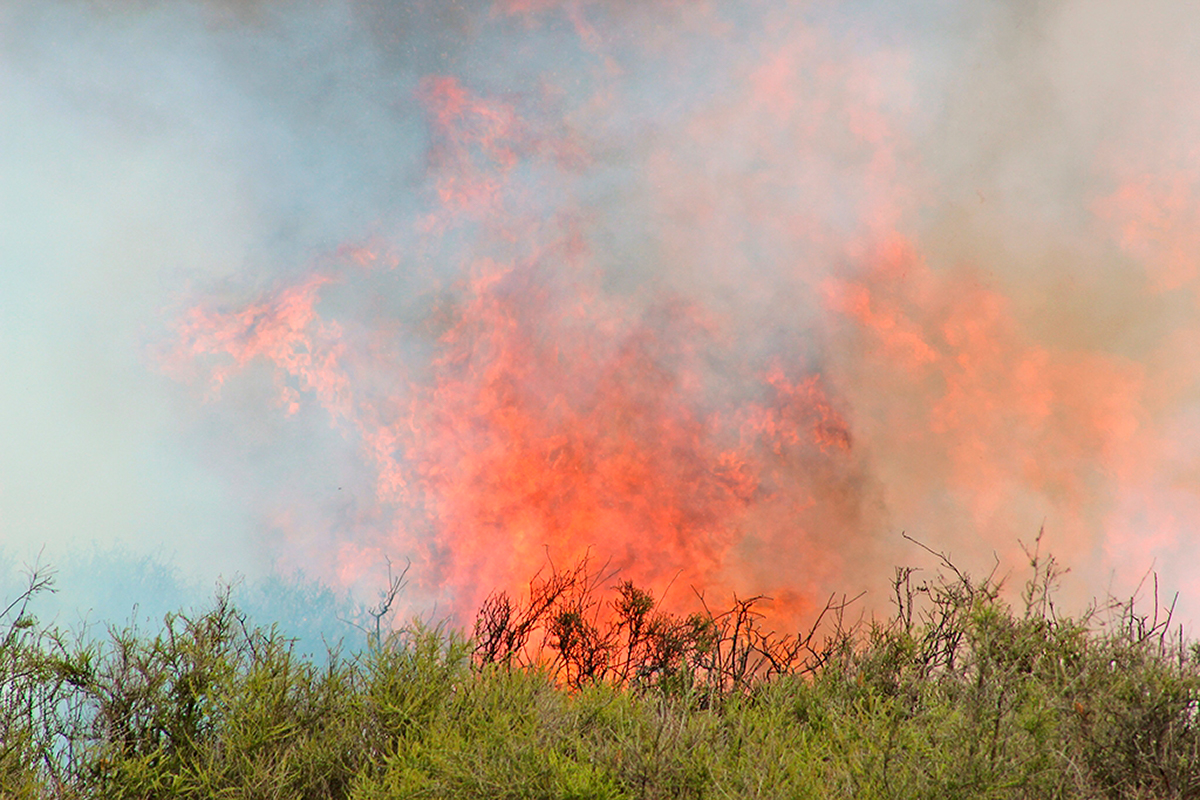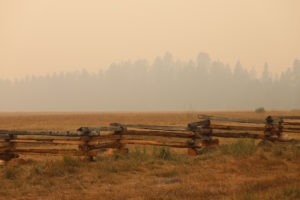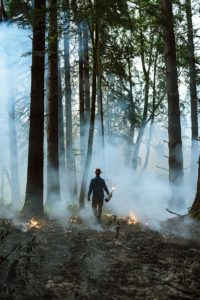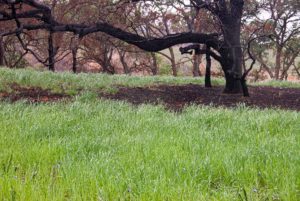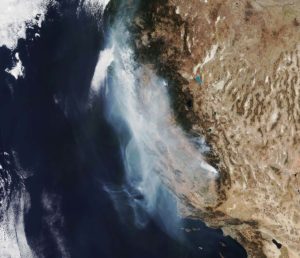The sky-scraping flames ate away at the Mendocino mountain’s chaparral vegetation, changing the chamise from shrub to smoke. The fire pumped out purple-gray billows until they melted into one storm cloud, thick enough to dull the fire’s intense color. Lindsey Hendricks-Franco, a UC Berkeley graduate student fire ecologist, watched. This one was her fire.
About a year later, in August 2017, Hendricks-Franco and I drove up the dry slopes at the Hopland Research and Extension Center, a cloud of dust and gravel trailing the car.
“It is a very impactful thing to see flames that high, and a landscape change so instantly,” she said as we entered the scene she’d watched burn.
Grizzled oak trees bent over in a protective stance over the dirt road. We drove out from the oaks’ shade to see miles of southern Mendocino County mountains out the passenger side window: the perfect reward for a long drive from Berkeley.
“It only gets better,” Hendricks-Franco said. A valley, patched with acres of the county’s not-so-well known Kelly green vineyards, lay between our mountain and the other brown-blue giants across the way.
Each mountain is naturally patched with its own unique configuration of ecosystems and vegetation: oak woodlands, grasslands, shrublands. It is the perfect display of the “California mosaic,” Hendricks-Franco says. But for now, she is interested in one reddish-green tile in that mosaic: chaparral, a shrubland ecosystem dominated on most of these slopes by the shrub called chamise.
The tile is no longer reddish-green. Hendricks-Franco and CalFire set the chaparral slopes at the research center ablaze in April 2016 and then again in October 2016, resulting in a new study site: 39.5 acres of charred chamise. We’re used to thinking about how fires regenerate the soil, allowing plants to recover and flourish. Hendricks-Franco wants to spin the question around and ask from a different perspective: what do plants do, after a fire, to allow the soil itself to recover? “Everyone knows that after a fire you get a flush of herbs,” she says. “A nature enthusiast or botanist would be excited about that botanical diversity. But what scientists find interesting is that having this many plants appear in such a short of time can have an impact on nutrient cycling.”

Chaparral is built to thrive after wildfires. Many seeds, including chamise, rarely sprout until after a fire. On top of this, the fire leaves a thin layer of ash rich in nitrogen, the nutrient which typically limits growth in chaparral ecosystems. Ash is the chaparral’s ticket to sustained recovery. The fire is a gift to this ecosystem as much as it is a force of destruction.
But there is a catch. The nitrogen is temporary. If plants don’t find it and hold it in place, it runs off into nearby streams and lakes with winter rains. Runaway nitrogen is bad both for the long-term health of the soil and for aquatic life. As dominant as it ultimately might be, chamise isn’t the plant to grab and fix the readily available nitrogen. Shrub regrowth will take years, and in the meantime, in a post-fire boom, other plants take advantage of the newly cleared space. The ones best equipped to grow are the ones that can most rapidly eat up the available nitrogen: wildflowers.
Normally, chamise and other sturdier plants hog the sunlight, making it nearly impossible for wildflowers to survive. After a fire, this is no longer a problem.
“The seeds for the wildflowers that you see after a wildfire have been hiding in the soil since the last wildfire,” Hendricks-Franco says. A bank of wildflower seeds deposited by the flowers that appeared after the last fire take root and begin to grow.
The spring after a 2013 wildfire on Mount Diablo, Hendricks-Franco watched “fire-following wildflowers” emerge from a Sleeping Beauty-like slumber for the first time since the mountain’s last fire — in 1977. She saw whispering bells and other wildflowers thrive again in 2016 following her prescribed fire at the Hopland center. Already botanists have reported whispering bells blooming in the areas burned in 2017 by the North Bay fires.
To answer her question about how plants affect soil, Hendricks-Franco wants to know which wildflowers take up more nitrogen than others.
When it comes to nitrogen, there are two types of plants. Some, called nitrogen fixers, can take nitrogen out of the air and convert it into a form they can use. They do this by a symbiotic relationship with nitrogen fixing bacteria, which the plants house in their roots. Other plants don’t have that relationship, and so they rely on taking up nitrogen from the soil. In general, it’s good to be a nitrogen fixer: Earth’s atmosphere is 78 percent nitrogen, so the resource is always available. But after a fire, non-nitrogen fixers have all the nitrogen they could possibly want readily available to them at their roots. Hendricks-Franco assumes that this translates into non-nitrogen fixers growing quickly after a fire, while the nitrogen fixers’ grow relatively slowly. “Non-nitrogen fixers are really hungry,” she says.
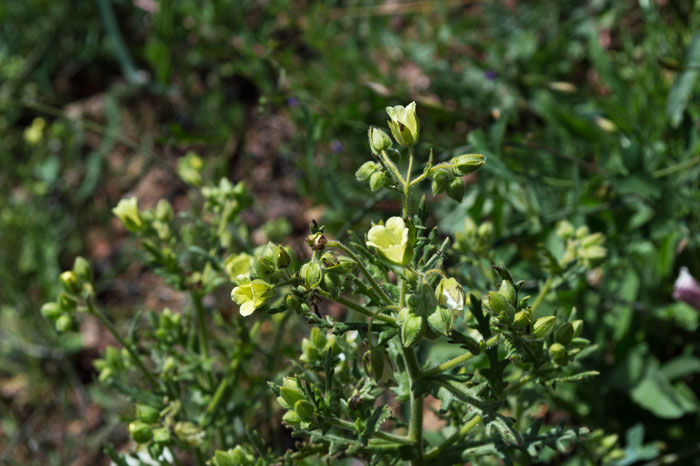
When Hendricks-Franco reaches the burned area, she pulls the car over near a scrawny tree that serves as shade, in a clearing that serves as a parking space. We are close to the top of the mountain. The very peak, covered in the dense red-green chaparral, is above us. On either side of us there are acres of yellow-brown burnt chaparral slopes.
As we walk up the hill, charred chamise skeletons bake in a bath of hot July sun. Her face glows with a bit of sweat as she bends down and examines the site; she frowns a little. Some shriveled wildflowers sprout between the chamise. The dried whispering bells seem to rustle instead of whisper in the inconsistent warm breeze.
Hendricks-Franco has divided the burn area into four types of plot. Some contain every type of plant. Some are weeded so they are either strictly chamise and nitrogen fixing plants, or strictly chamise and non-nitrogen fixing plants. Others are control plots where she weeded everything but the chamise.
Hendricks-Franco’s plan is to watch for two or more years to see which types of plants take the most nitrogen from the soil.
To measure plant density she uses a “point frame” — a three-foot by three-foot hard plastic square, with three legs extending down to the ground so it looks like a small table. There are about 50 equally spaced holes drilled into the hard plastic top. Twenty are filled with thin metal pins that extend through the holes down to the ground.
Hendricks-Franco places the whole contraption over an area in the plot, and then crouches down next to it. She records the quantity of plants that have roots within the area, then counts the number of times a plant hits each pin.
“GalCal seven,” she calls out, signifying that Galium californicum, or California bedstraw, has touched a pin seven times.
Hendricks-Franco and a small group of undergraduate assistants do this for several more hours, calling out shortened versions of plant names like “Eriodictyon californicum,” or “Emmenanthe penduliflora.”
It’s hot work, made harder by the relentlessly stiff chamise skeletons.
“With chamise,” Hendricks-Franco explains, “you just have to forge through it
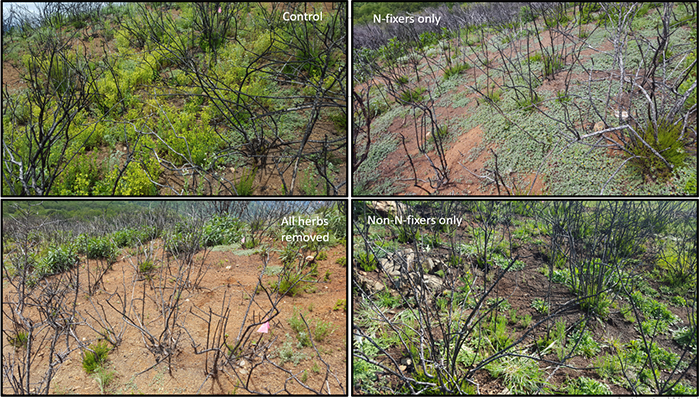
A few days later, I go visit Hendricks-Franco at her lab in Berkeley.
As we left the research site, Hendricks-Franco had worried that the plants hadn’t grown back thickly, and that without enough points touching the frame, she wouldn’t be able to trust it in the future as a sampling tool.
In the lab, Hendricks-Franco opens a spreadsheet where she’s entered records of the total biomass of plants she’s harvested from her site, and how dense those plants were (measured by how many times the plant hit the pins on her point-frame). The data should form a relatively straight line when graphed: basically, the more plants that hit the point frame, the heavier the plant biomass of the plants she actually pulled out of the ground.
She asks the spreadsheet to graph the results, and up pops three nicely arranged scatter plots, all with strong positive associations. The undergraduate researcher, who had been helping earlier that day, claps.
“I don’t think I could ask for better,” Hendricks-Franco says.
Hendricks-Franco is already visiting her sites again this winter. She’ll monitor them through the spring, and then again next year, before concluding the experiment. She hopes, by the time she’s done, to better understand how a landscape rebounds following a fire, a time when post-fire recovery is top of mind for Californians. But for now she cautions against extrapolating too much to non-chaparral ecosystems.
“Every year is a little different,” she says. “Every plant is a little different. But we still need to understand them to make sense of our changing world.”
Hannah Johansson is a Bay Nature editorial intern and a high school senior at Castro Valley High School.

